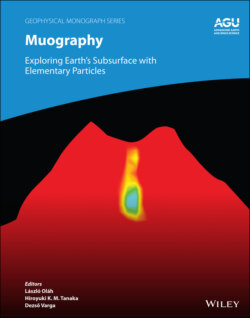Читать книгу Muography - Группа авторов - Страница 40
2.4 PERFORMANCE ESTIMATION WITH A FORWARD MODELING SIMULATION
ОглавлениеThis section describes an example of performance estimation using the two reconstruction methods.
The following assumptions and models were used in the simulation. The volcano selected as an example is Omuroyama, located in Ito, Shizuoka Prefecture, Japan. Omuroyama volcano is an inactive scoria cone that is part of the Eastern Izu Monogenetic Volcanic Group, and formed at ca. 4 ka. The basal diameter of the volcano is 800–1000 m, and its relative elevation is ~250 m. Multi‐directional muon tomographic study is ongoing at this volcano for the following reasons: (i) good accessibility for installation of muon detectors in all directions due to well‐maintained roads; (ii) the absence of “shadows” from any other objects in the background; and (iii) the volcano shape is axisymmetric, but non‐axisymmetric structures are expected in the volcano interior (Koyano et al., 1996; Saito et al., 2003).
The other parameters used in the simulation are as follows. The topographic data were published by the Geospatial Information Authority of Japan, and the grid size is 5 m for both the longitudinal and latitudinal directions. The minimum voxel unit that makes up the volcanic body is a cube with dimensions of 20 × 20 × 20 m3. We used two types of input density structures. One is a checkerboard structure, which consists of 100 × 100 × 100 m3 cubes with densities of 1.0 and 2.0 g/cm3, respectively (Fig. 2.5d). The other structure consists of two vertical cylinders inside the mountain, each cylinder has a density of 2.0 g/cm3 and a diameter of 100 m, and the rest of the mountain body has a density of 1.5 g/cm3 (see Fig. 2.9d). The detectors were placed on the surface in a near-circular array around the volcano (Fig. 2.4). The viewing range of each muon detector in the azimuth angle is ± 1.5 in tangent. The range in the elevation angle is 0.0–1.5 in tangent. The minimum size of the angular bins for the penetrating muon flux calculation is (0.01)2, then the number of muons in each bin was then merged into larger bins of (0.05)2 as shown in the Fig. 2.1. For simplicity, the thickness of the detector was assumed to be negligible compared with the length of the effective sensitivity plane, and all the muon detection efficiencies were assumed to be 100% with no angular dependence. The model for the muon fluxes was based on Honda et al. (2004), and we used the method of Groom et al. (2001) for the energy loss of high‐energy muons. The total summation product of the effective area × exposure time is 900 m2 d. For example, when the number of observation directions is 16, the product of the effective area × exposure time per direction is 900/16 = 56.25 m2 d.
Figure 2.4 Topography around Omuroyama volcano and the location of the muon detectors in the simulation. The coordinate origin is the summit of Mt. Omuro-yama (Latitude 34°54′ 11″, Longitude 139°5′ 40″). White dots imply the detector locations of the 16‐directional muography. In the case of 4‐directional muography, the detectors were placed at the northern, eastern, southern, and western points; in the case of 8‐directional muography, additional detectors were located to the northeast, southeast, southwest, and northwest. The small vent on the southern flank has an elevation of 450 m a.s.l.; the crater rim elevation is 535–580 m a.s.l.; the base of the crater is at 510 m a.s.l.
For simplicity, we assumed that the muon detectors have enough capability to reject low‐momentum particles (i.e., the effect of multiple Coulomb scattering is negligible). This assumption is required as the computational needs are too large to calculate the scattering effect. There have been several studies of the contamination of low‐energy particles due to the multiple Coulomb scattering effect around mountains (e.g., Ambrosino et al., 2015; Jourde et al., 2013; Nishiyama et al., 2014b, 2016).
